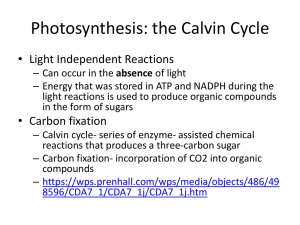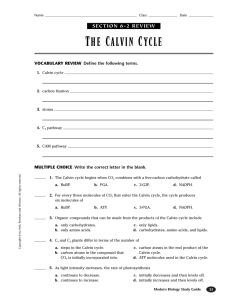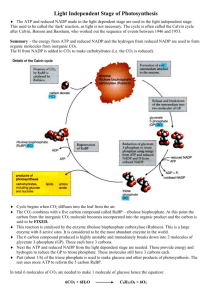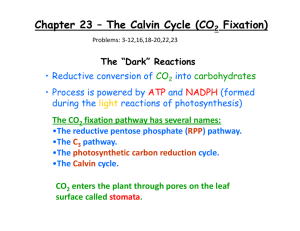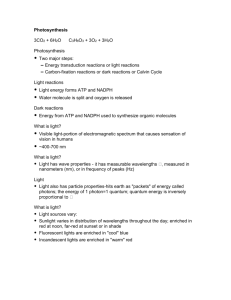Lecture #11 - Faculty Virginia
advertisement
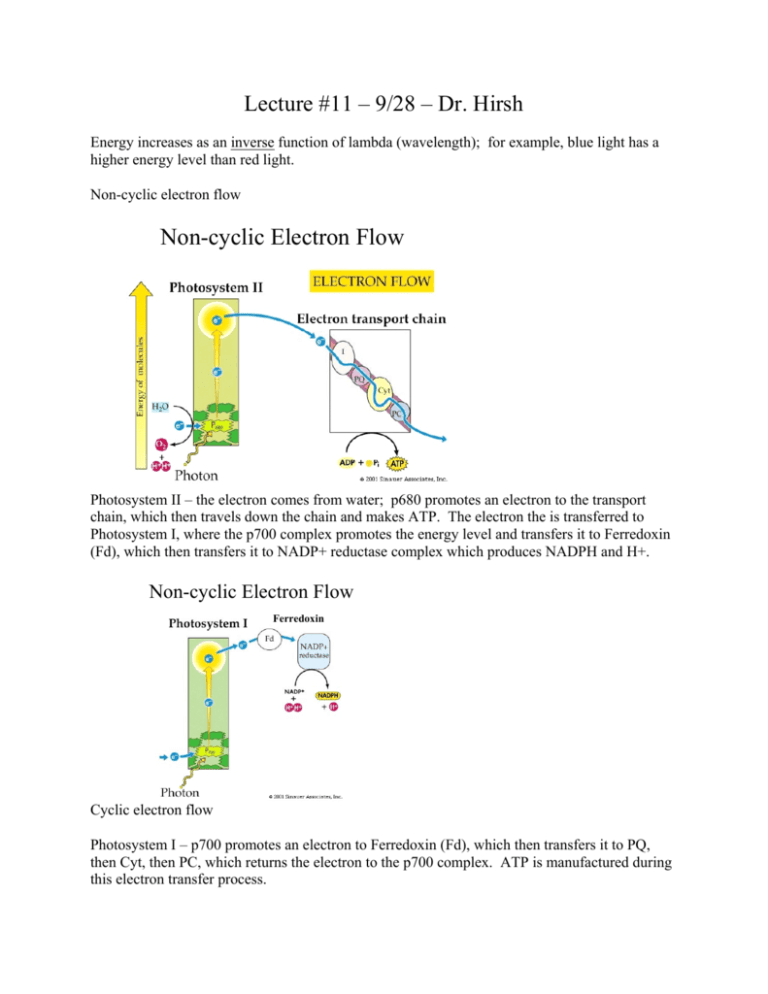
Lecture #11 – 9/28 – Dr. Hirsh Energy increases as an inverse function of lambda (wavelength); for example, blue light has a higher energy level than red light. Non-cyclic electron flow Non-cyclic Electron Flow Photosystem II – the electron comes from water; p680 promotes an electron to the transport chain, which then travels down the chain and makes ATP. The electron the is transferred to Photosystem I, where the p700 complex promotes the energy level and transfers it to Ferredoxin (Fd), which then transfers it to NADP+ reductase complex which produces NADPH and H+. Non-cyclic Electron Flow Ferredoxin Cyclic electron flow Photosystem I – p700 promotes an electron to Ferredoxin (Fd), which then transfers it to PQ, then Cyt, then PC, which returns the electron to the p700 complex. ATP is manufactured during this electron transfer process. Cyclic Electron Flow: Produces additional ATP req’d for dark rxns. Chemiosmosis produces ATP Electron flow down the electron transport chain causes H+ transport from the stroma of the chloroplast to the interior of the thylakoid space. The gradient is 4 pH units, drives ATP synthase machine. In a test tube, if you place chloroplasts, ADP and Pi in solution, then raise the pH, you can cause the synthesis of ATP by the induced gradient. Note: in mitochondria, the H+ are pumped into the outer space from the inner space. Calvin-Benson cycle: The dark reactions Calvin-Benson Cycle: The dark reactions 3-Phosphoglycerate CO2 + Ribulose 1,5 bisphosphate + rubisco -> Six carbon skeleton (very transient) -> 2 molecules of 3 Phosphoglycerate Tracing products of this reaction Give photosyntesizing algae a pulse of radioactive 14CO2 – what are the instantaneous products? Give algae pulses of 14CO2 30 sec pulse 3 sec pulse If we give a 30 second pulse of If we give a 3 second pulse of 14 14 CO2, all metabolics in the dark reaction are radioactive. CO2, only 3 Phosphoglycerate is radioactive This implies the initial reaction (6 carbon skeleton) is very fast; the downstream reactions run slower. Pulse-chase experiments and metabolic pathway analysis – give pulses of 10 seconds, 30 seconds, 3 minutes of unlabelled CO2 – resolve sequence of metabolic steps. Calvin – Benson Cycle Results in CO2 fixation. A 5 Carbon sugar (RuBP) + CO2 -> 2 molecules of 3PG: consumes ATP, NADPH This cycle regenerates the RuBP used in the first step. The end product: Glyceraldehyde 3 Phosphate, which can be used to make larger sugars and/or pathway intermediates. Calvin cycle: 6 CO2 enters, adds to 6 RuBP -> 12 3PG + 12 ATP + 12 NADPH -> 12 G3P 10 of the G3P + 6 ATP-> 6 RuBP 2 of the G3P -> one 6 carbon sugar Calvin-Benson Cycle ~5/6 th ~1/6 th Photorespiration The process of the fixation of oxygen by rubisco RuBP + O2 – glycolate -> glycine -> -> serine + CO2 This reduces CO2 fixation; depends upon relative concentration of each molecule. Air O2 = 20%; CO2 = 0.036% This reaction is a problem at high temperature, low moisture; gas exchange is limited at the leaf by stomatal closing. Rubisco must be very selective binding CO2 versus O2 If we don’t have free diffusion of gases (stomata closed) -> increased level of oxygen in the leaf [from light reaction!], decreased concentration of CO2 , thus increase in the rate of photorespiration. C4 Metabolism These plants use oxaloacetate [remember this from the Krebs cycle?] as a C4 acceptor, and uses PEP carboxylase as the fixing enzyme. PEP carboxylase has a higher affinity for CO2; no oxygenase activity. It’s found in sugar cane and crab grass. Note sugar cane is one of the most efficient plants known; captures approximately 8% of the energy of the sun’s light as chemical bonds. The C4 pathway is a very recent evolutionary development – less than 12 million years old. In C4 plants, the palisade cells under the leaf’s upper surface contain PEP carboxylase; the cells surrounding the vein (bundle sheath cells) perform the Calvin [C3] cycle and contain rubisco. Thus there is a physical separation of CO2 fixation step and sugar formation steps. To summarize: in C4, mesophyll fixes the CO2. Bundle sheath cells perform the Calvin cycle. CAM metabolism This is found in cacti and other succulents. They separate CO2 fixation and the Calvin cycle temporally – night and day. CO2 is fixed at night; the Calvin cycle performed during the day when the stomates are closed. C4 Plant CAM Plant Modern biological work in plants based in developmental genetics, mostly using Arabadopsis sp. There can be metabolic conversions with intermediates in plants – in their citric acid cycle, alpha keto glutarate can be converted utilizing ammonia from the soil to produce necessary amino acids. Metabolic Interconversions with Intermediary Metabolism Different parts of cells in general are reducing and oxidizing. Extra-cellular regions are basically oxidizing/ intra-cellular areas are basically reducing. How does oxygen exit the plant cell without forcing oxidation of existing –SH groups in the cytoplasm? Is there a carrier of oxygen to shuttle it out of the cell? Perhaps glutathione? This is a question without a current answer!
